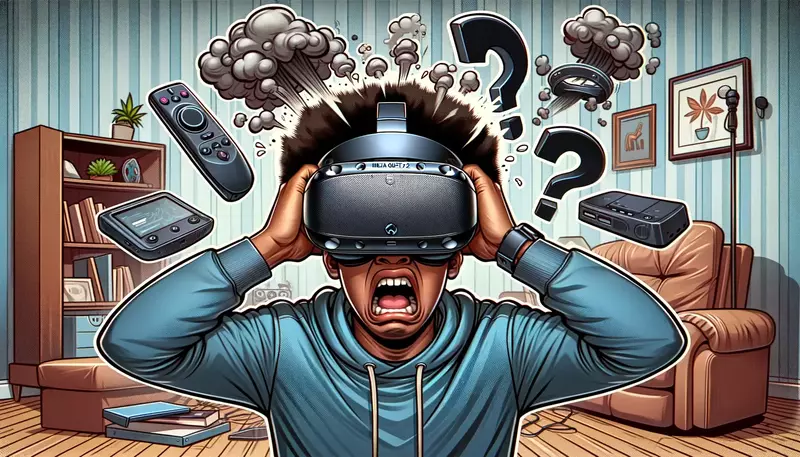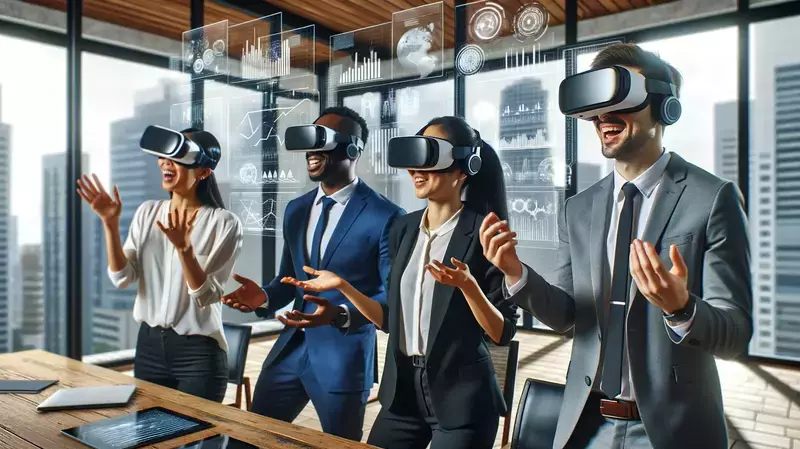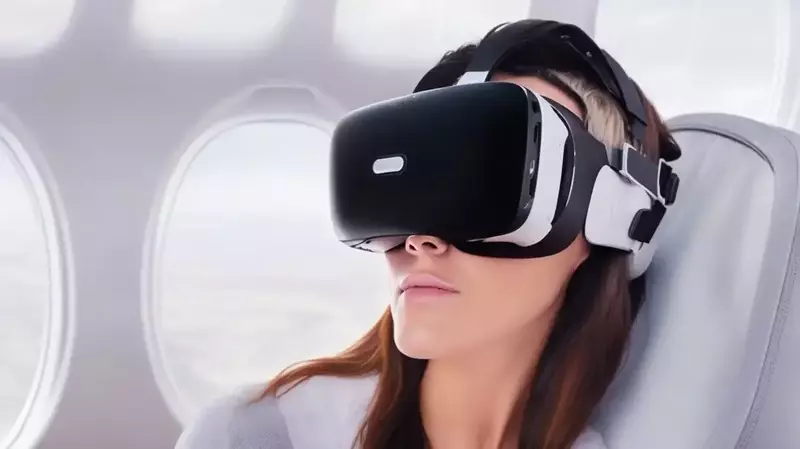This site contains affiliate links to products, and we may receive a commission for purchases made through these links.
VR is an exhilarating, novel tech that provides numerous possibilities for digital marketers. By creating immersive experiences, VR can help brands engage with their target audiences in ways never before possible.
In this blog post, we will explore the potential of virtual reality in digital marketing and discuss how it can be used to create powerful campaigns that drive customer engagement and conversions. We’ll also examine how successful virtual reality campaigns have been, and the challenges marketers may face when utilizing this innovative technology.
So if you’re looking to get ahead on the latest trends in digital marketing, read on to learn more about the incredible opportunities does virtual reality provides.

What is Virtual Reality?
Virtual reality (VR) is an interactive computer-generated simulation of a three-dimensional environment. It can be experienced through the use of special electronic equipment, such as headsets with screens inside or gloves fitted with sensors. This technology provides an immersive experience that facilitates user engagement and involvement beyond what is achievable in reality.
VR has been implemented for years in numerous areas, from entertainment to medical care and instruction. But now it’s being incorporated into marketing strategies across all sectors, allowing companies to deliver unique experiences that engage customers more deeply than ever before.
Augmented reality (AR) is another form of technology that combines real-world objects with virtual elements to create an enhanced user experience. AR overlays digital content onto the physical world around us, often using head-mounted displays or smartphones equipped with cameras. While VR immerses users completely in a virtual environment, AR augments their existing surroundings by adding layers of information on top of them—creating what some have called “mixed reality” environments.
The most common way people access VR today is through headsets like Oculus Rift and HTC Vive, which are designed specifically for this purpose and come equipped with motion tracking systems so you can move your body within the virtual space without getting lost or disoriented. Mobile devices such as Samsung Gear VR also allow you to explore 3D worlds without needing any additional hardware beyond your phone itself—allowing anyone who owns one access to incredible experiences at home or on the go.
For those who are advanced level professionals with an IQ of 150, Unity3D game engines make it a breeze to craft engaging stories set within 3D virtual worlds. Furthermore, Google Cardboard platforms offer smartphone and tablet users access to straightforward yet powerful tools for constructing their own personalized experiences in no time. Keywords: Unity3D, Google Cardboard, Engaging Stories, Virtual Worlds, Personalized Experiences.
Virtual reality is a technology that creates an immersive experience in which users can interact with 3D environments. Investigating the potential of virtual reality for digital marketing and its advantages is worth considering.
Benefits of Virtual Reality in Digital Marketing
VR can be utilized by digital marketers to generate engaging, unforgettable encounters. By incorporating VR into their marketing strategy, businesses can create immersive experiences that engage customers and deliver memorable experiences.
VR provides businesses with a way to craft virtual realms that can replicate actual circumstances, affording users the chance to experiment with novel products or services without needing to go anywhere. By immersing customers in a virtual environment, companies can create an engaging experience that could help to convert potential customers into purchasers.
In addition, VR offers marketers the chance to get creative with how they present their brand and its products or services. By combining VR headsets such as Oculus Rift and HTC Vive with AR technology, marketers have the opportunity to craft a distinct experience for users when engaging with their brand’s offerings. By utilizing interactive content, brands can gain a competitive edge by offering customers an unparalleled experience that cannot be achieved through traditional advertising.
VR affords an opportunity for companies to make international connections, enabling them to reach out globally with a personal touch in spite of the geographical distance. VR tech offers a way for firms to bridge the gap between far-off consumers, enabling them to make contact and foster relationships like never before.
Finally, using virtual reality also gives marketers valuable insights into customer behaviour; what works best when trying to engage consumers? What kind of content do they respond positively too? With this information at hand, companies are better equipped than ever before when crafting future campaigns designed specifically around user preferences rather than guesswork alone.
Overall, virtual reality provides a unique and powerful way to engage with digital marketing. With its immersive capabilities, businesses can create an experience that will leave customers wanting more. Examples of Virtual Reality in Digital Marketing provide further insight into the potential this technology holds for marketers.
Examples of Virtual Reality in Digital Marketing
As the popularity of VR increases, it is increasingly being used in digital marketing to create immersive experiences that engage customers and allow them to explore products or services from different angles. VR technology can create a fully interactive environment, captivating customers and enabling them to examine products or services from various perspectives.
One example of virtual reality in digital marketing is virtual tours. Companies can use this technology to create realistic 3D models of their products or services, allowing customers to take a “virtual walk” through their offerings before they make a purchase decision. Potential customers can gain confidence in a company’s offerings by virtually experiencing them before committing to buy, allowing for an immersive experience as if the product or service were being utilized in reality.
Another way companies are leveraging virtual reality for digital marketing purposes is interactive product demonstrations. By utilizing interactive product demonstrations, businesses can provide customers with a virtual experience of their products that is more immersive and engaging than traditional video tutorials. Through interactive demonstrations, viewers have more control over what they see and learn about each product than traditional video tutorials could ever provide.
Finally, many companies are also using VR technology for events such as conferences and trade shows where physical attendance may not be possible due to travel restrictions or other factors related to COVID-19 pandemic safety protocols. By creating fully immersive environments within these events, attendees can get a taste of what it’s like being there without leaving home – all while gaining valuable insights into new products and trends within their industry sector that might otherwise go unnoticed during physical events
Overall, virtual reality provides marketers with powerful tools for engaging with current and potential customers alike by offering unique experiences that cannot be replicated elsewhere – making it an invaluable asset when it comes to digital marketing campaigns today.
VR furnishes an enthralling, immersive involvement for patrons, thus rendering it a potent mechanism in digital marketing. Marketers must be aware of the challenges associated with using virtual reality to ensure that their campaigns are successful.
Challenges Faced by Marketers Using Virtual Reality
Using virtual reality in digital marketing can be a powerful tool for engaging customers, but it comes with its own set of challenges. A key challenge is the cost associated with virtual reality in digital marketing. Creating high-quality VR experiences requires specialized hardware and software, which can be expensive to purchase and maintain. Moreover, the cost of constructing content for such experiences must be taken into account, including recruiting 3D animators or buying pre-made resources from external providers.
Technical challenges are also an issue when creating VR experiences for digital marketing campaigns. Developing immersive content that appeals to users requires expertise in game development and animation techniques that many marketers may not possess. Furthermore, making sure these experiences run smoothly on various devices without any glitches is another challenge faced by marketers using virtual reality in their campaigns.
Another issue is user engagement; while some people may find virtual reality exciting at first glance, they quickly become bored if there isn’t enough variety or interactivity within the experience itself. Marketers need to ensure that their VR content provides a compelling story or interactive elements that keep users engaged throughout the entire experience.
Finally, measuring success with virtual reality presents yet another challenge for marketers since traditional metrics such as clicks and impressions do not necessarily apply here due to the unique nature of this technology. Marketers must develop creative ways to measure user engagement with their VR content in order to gauge how effective it has been in driving sales or other desired outcomes from customers who have experienced it firsthand.
FAQs in Relation to What Opportunities Does Virtual Reality Provides in Digital Marketing?
What opportunities does virtual reality provides in digital marketing?
Digital marketers can leverage virtual reality to create engaging, immersive experiences for their customers, strengthening the bond between brand and consumer. It allows them to create experiences that are not only memorable but also highly engaging, creating stronger connections between the brand and customer. Virtual reality can be used to create customized content such as virtual tours of products or services, simulated shopping experiences, educational courses or even interactive games that help build loyalty among consumers. By utilizing this technology, digital marketers have access to powerful tools which can help increase engagement rates and conversions significantly.
What are the opportunities of virtual reality?
With its ability to revolutionize how we engage with technology and our surroundings, virtual reality has the potential to be a game-changer. VR offers a captivating, interactive experience which can be applied to gaming, leisure activities, teaching simulations, data representation and much more. VR also allows us to explore virtual environments in ways never before possible – from exploring outer space or ancient ruins to visiting distant lands without leaving our homes. VR has the potential to be a major player in tech, given its increasing capacity and utilization across various sectors like healthcare, engineering and architecture.
What is the use of virtual reality in marketing?
Virtual reality (VR) is an emerging technology that has the potential to revolutionize marketing. VR offers a novel, captivating encounter for customers, allowing them to interact with offerings in ways that weren’t possible previously. VR can be used to create compelling campaigns that capture attention and generate leads. VR offers businesses the chance to display their offerings in virtual settings, giving customers an opportunity to explore without ever having to leave their homes. Furthermore, VR allows companies to track customer engagement and tailor experiences accordingly – providing invaluable data on consumer behavior. In short, VR offers marketers new opportunities for engaging consumers while gaining valuable insights into how they respond to different campaigns or offerings.
How does metaverse help digital marketing?
Metaverse technology can help digital marketers reach a wider audience and build more engaging experiences. Metaverse tech enables marketers to craft virtual realms that customers can explore, communicate with, and make purchases in real-time. Through the use of 3D models, animations, videos, sound effects, and other interactive elements such as avatars or voice commands, metaverse technology allows for an immersive experience that encourages customer engagement. This leads to increased sales opportunities by providing a unique platform for marketing campaigns while also creating brand loyalty through its ability to personalize content based on user preferences.
Conclusion
In conclusion, virtual reality offers a wide range of opportunities in digital marketing that can help businesses reach their goals. With the right strategies and tools, marketers can use VR to create immersive experiences for customers that will leave them with lasting impressions. Despite the difficulties associated with VR in digital marketing, these are outweighed by its potential advantages. Marketers should take advantage of this technology and explore its various possibilities so they can make the most out of its unique capabilities when creating campaigns for their products or services. By doing so, they will be able to maximize their chances of success by taking full advantage of all the opportunities does virtual reality provides in digital marketing?
Discover how virtual reality can revolutionize digital marketing by exploring the opportunities it provides. Take advantage of these possibilities and learn more about this exciting technology today!
!! For more information about the different VR headsets on the market, check out this product specification list.

Espen
Espen is the Director of PursuitMeta and has written extensively about Virtual Reality and VR Headsets for years. He is a consumer product expert and has personally tested VR Headsets for the last decade.




Leave a Reply